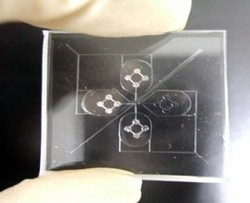Careful orientation of permanent magnets allows biologists to manipulate cells with high precision

Fig. 1: A microfluidic chip with three orthogonally arranged magnetically driven microtool (MMT) arms for cell manipulation. Each of the three tool arms, pointing toward the center, is controlled by a set of four permanent magnets.
Physical scientists and engineers have often made substantial contributions to biology and medicine. X-rays and magnetic resonance imaging are classic examples. Now another useful tool, this time for scientists working with cell manipulation, is emerging from work by biorobotics experts at Nagoya University. Fumihito Arai from the GCOE for Micro-Nano Mechatronics and co-workers have demonstrated how to achieve precise positioning of large cells using permanent magnets1.
The researchers developed magnetically driven microtools (MMTs) that can be used to manipulate cells inside microfluidic chips. "MMTs allow non-contact manipulation, which is good for realizing mechanical interactions inside the chip," says Arai.
Previously, tiny electromagnets have been used to achieve reasonably precise manipulation of small objects, but the magnetic forces generated are usually too small to control large molecules or cells. To overcome this problem, Arai and his co-workers set out to build a device based on permanent magnets instead.
Their task was more difficult than it sounds. An MMT can be dragged around on a surface by moving a permanent magnet underneath the stage, but control over the tool is lost when the magnet passes directly underneath, an effect referred to as the 'dead band'. In practice, the dead band area extends for about half a millimeter around the MMT, around five times the size of the cells that researchers would like to manipulate.
The team's first challenge was therefore to understand the origin of the dead band. They performed computer simulations of an MMT dragged by a neodymium magnet and found that the magnetic friction generated by a permanent magnet exceeds the dragging force when the magnet passes directly beneath the tool. However, the same simulations showed that simply rotating the magnetic axis of the magnet by 90° lowered the friction substantially.
Based on these findings, the team fabricated a new driving tool using a 'horizontal polar drive' design in which a set of four permanent magnets control an extended MMT arm (Fig. 1). This configuration ensures that the position of the MMT arm can be controlled very precisely in two dimensions. Arai and his team demonstrated the potential of the device was by using it to translate and rotate an oocyte cell of about 120 micrometers in diameter.
"The resolution in positioning was 51 micrometers when we submitted our paper. However, we have improved this by a few micrometers by reducing the friction between the MMT and the microchannel," says Arai.
Affiliated Researchers
The Nagoya University affiliated authors mentioned in this highlight are from the Education and Research of Micro-Nano Mechatronics GCOE program of the Department of Mechanical Science and Engineering.
Reference
- Hagiwara, M., Kawahara,T., Yamanishi, Y. & Arai, F. Driving method of microtool by horizontally arranged permanent magnets for single cell manipulation. Appl. Phys. Lett. 97, 013701 (2010). | article